#solar-plus-storage
Text

Northern New Mexico 🔋👷🏽♂️
#solar powered#solar energy#photography#nature photography#landscape photography#land back#renewable energy#engineering#engineer#photovoltaic#new mexico#gods country#taos#Solar plus storage#👷🏽♂️
7 notes
·
View notes
Text
Solar Power and batteries have the Potential to Change Our World
Its mind-blowing how much energy the sun produces for free every day. Adding solar panels and batteries is one of the best decisions you will ever make to save money. #BESS #ESS #solarplusbattery #energyindependence
The sun’s power is immense – enough to fuel our planet for millennia. While we haven’t fully tapped into this potential, solar technology is rapidly advancing. Let’s explore what solar can do for us today and how it transforms our future.
Harnessing the sun’s power changed everything! It’s not just about energy; it’s about a cleaner, more sustainable world.
But what does a solar-powered future…

View On WordPress
#C&I#Energy Storage Systems#ESS#liquid cooled battery#micro grods#Solar plus battery#Wincle energy storage systems
0 notes
Text
Inverters: Here's Everything You Need to Know
More and more people are turning to wind and solar-plus-energy-storage systems as the preferred method of powering their homes and businesses. These systems are reliable, cost-effective, and can be used to run a wide variety of devices. In order to be energy independent, however, you will need a battery and an inverter to power your storage system. Inverters can be extremely helpful in a variety of settings and lifestyles, including when you frequently go camping, when you live off the grid, or when you simply want a backup power source. If you're interested in purchasing an inverter but aren't sure where to begin your research, this article will cover everything you need to know, including how inverters function, the different types of off-grid inverters, and more.
How do inverters function?
The term "power electronics" refers to a class of devices that regulate the flow of electricity, such as inverters. A power inverter is a device that converts direct current (DC) from a power outlet to alternating current (AC). The inverter can perform this conversion by rapidly switching the direction of the DC input. The input will actually reverse through the circuit nearly 60 times per second! Batteries and solar panels both operate on DC, but most homes and the electrical grid operate on AC, so inverters are commonly used in solar-plus-storage systems. Therefore, you will need a DC-to-AC converter in order to use the energy produced by solar panels, stored in solar batteries inside your home, or used in conjunction with the electrical grid.
The inverter uses semiconductors to rapidly invert the polarity of the direct current input, transforming it into an alternating current (AC) voltage. The output AC voltage is typically equal to the grid supply voltage of 120 or 240 volts, depending on the country, whereas the input DC voltage is typically lower, such as from a 12V or 24V battery. In order to determine the right kind of battery and inverter for your needs, you will simply need to consider what you intend to use the inverter for, how much energy it will require, and how long it will be in use.
Inverter Types
There are two primary options when shopping for an off-grid inverter: pure sine wave inverters and modified sine wave inverters. Keep in mind that there are differences in how much they cost, how efficiently they work, and how often you can use them. In order to determine which option is the most realistic and affordable, you must first assess your requirements.
Pure Sine Wave Inverters
Pure sine wave inverters operate on the same type of electricity that is supplied by a generator or the power grid. These inverters may be less expensive than others, but they are optimized for sine waves, can power large appliances, and give their users greater freedom and security. Still not sure if a pure sine wave inverter is essential for your needs? This should be your first choice when looking for a power source for a microwave, refrigerator, or other appliance that uses a motor. This will guarantee that your inverter has a long life and produces clean, reliable electricity.
Modified Sine Wave Inverters
Modified sine waves, on the other hand, are effective at frequencies above 60Hz. Although they can supply electricity to most devices, their performance may not be as good as it would be with a pure sine wave inverter. A clock that runs on a modified sine wave, for example, will still function, but it will run faster or slower. If the presence of slight imperfections in the device's operation is tolerable, a modified sine wave inverter may be adequate. Customers on a tighter budget will be happy to know that modified sine wave inverters tend to be less expensive.
Inverters: What You Need to Know Before Buying
For those who need one for sensitive appliances, off-grid living, or when the power goes out during a storm, the decision to buy an inverter can feel like a huge one. You need to know that your inverter will work reliably, no matter what happens.
Calculating Your Inverter's Output Based on Your Power Demands
In order to make an informed decision about an inverter, you should first calculate the total electrical load of your appliances. Make sure you ask yourself the following questions when doing the math:
How many watts does your appliance need constantly?
How many appliances do you intend to use simultaneously?
When all of the appliances are turned on, how much of a power draw (or surge) is there?
How long does one need to operate each device?
With this information in hand, you can begin shopping for a suitable inverter and battery to meet your peak load demands. The maximum electrical demand during a given time period is measured as "peak load." Add up the wattages of all the devices you intend to use to get an idea of how much power you'll need. Calculate your energy costs at 20% more than the total wattage of all your appliances to account for potential energy losses. Find the inverter's voltage by consulting the electrical requirements detailed in the product's documentation.
Suppose you want to use your laptop and toaster oven simultaneously, and you need 1,200 watts of power total. Simply add 240 (representing 20% of the 1,200 watts) to get a total of 1,440 watts. In other words, you'll need an inverter with at least 2,000 watts.
Visit Worldwide Voltage online store to choose from the latest collection of power inverters of various watts. The leading supplier of 220 volt electronics appliances offers each of its products at a 2% lesser price than any quote you have received from any of the retail stores near you. Place your order today and enjoy uninterrupted power supply at your home or shop or office.
0 notes
Text
The United States solar energy boom is finally taking off - in the worst way. In the Mojave desert and other federal lands across the West, utility-scale installations are putting gigawatt-hours of energy on the board and powering millions of homes. But the designs are sloppy, the labor conditions are horrific, and the environmental damage is incalculable. Ancient joshua trees are being clear cut, endangered desert tortoises are being left for dead, the vast biotic carbon stores of Mojave soils are being upturned, and the reflectivity of enormous expanses of desert are being altered, affecting the planetary climate.
But it doesn't have to be this way. There's a type of energy that requires no fuel and no land. It hardly even needs transmission lines, as it can be built at the site of use: rooftop solar. Every hour of the day, rooftops across the United States soak up enough sun to generate petawatts of power. Estimates for their potential to offset US energy demand range from 13 percent to over 100. Yet at present, only around 2 percent of US energy is generated by rooftop.
And then there's land area that's already been developed. Just by building solar on degraded lands, focusing on superfund sites, reservoirs, and farmland, researchers estimate we could generate more than enough to offset today's national energy demand. While there are points of dispute concerning some projections, the conclusion is clear: between the potential of degraded lands, rooftops, wind, and storage - plus existing hydro, nuclear, and other zero carbon energy sources, there's really no need to tear up the rare and fragile ecosystems of our deserts.
1K notes
·
View notes
Text


What is going on with this 2010 earth ship in Montrose, CO? Usually, I like earth ships, but this is madness. 2bds, 2ba, asking $825K.
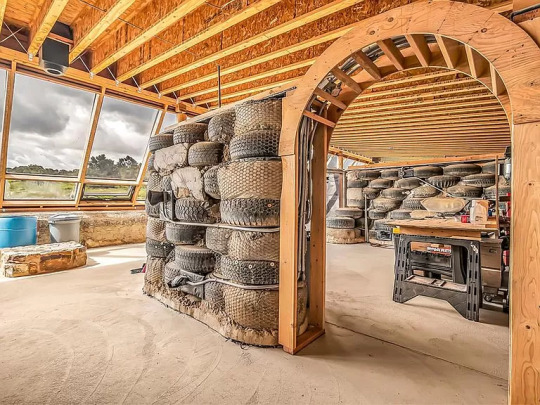
It's been 24 yrs., and it's still not finished. The buyer has to finish it. This is ugly. Look at the tire walls.

It's interesting for us, from an architectural standpoint, to see how an earth ship is made. So this is that garden area they always have at the entrance.
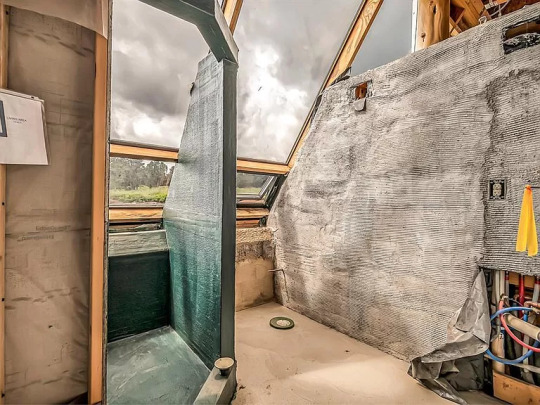
Bathroom?

Look at this. I first thought that these were clothes hanging. The tires are vertical and some are clearly flat.

On this wall they're horizontal. So, you put the adobe on these? So, you frame them and put up wallboard?
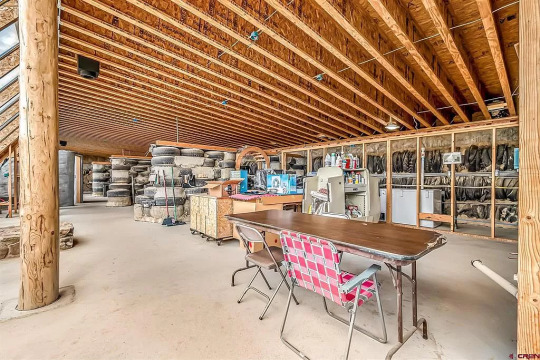
What a project. How can you figure out how to finish what someone else started?

Don't know what this is.

So, these batteries have been here since 2010.

The solar panel. Surprised there's just one.

39.90 acres of nice trees, but they cleared out the land around the house too much. They didn't leave any trees.


The earth ship looks big, and it looks like there's a house on the property, plus a shed and so many outbuildings, plus a trailer. The description says: "These can serve as storage, workshops, artist studios, or whatever else your heart desires."
https://www.zillow.com/homedetails/230-Sunrose-Ln-Montrose-CO-81403/104593806_zpid/?
86 notes
·
View notes
Text
—
From what I understand there were plans to build a new methane gas plant in or near Memphis (a place that is particularly vulnerable to the climate crisis) and thanks to community action (a lot of people were involved) it seems as though these plans have been scrapped in favor of solar power and storage.
#good news#environmentalism#memphis#texas#usa#environment#conservation#climate change#global climate change#solar power
13 notes
·
View notes
Link
8 notes
·
View notes
Text
I have an idea for a small hamlet deep in hills and woods.
The central gathering point is a common area with an outdoor stage and benches like a campground and a longhouse that is a multipurpose structure. A section partitioned for equipment storage for well drilling, dirt road maintenance, scaffolding, timber sawmill, etc. A workshop of various disciplines to build whatever is needed and teach new skills. And finally a kitchen for community events.

Surrounding this common agora would be driveways to individual homesteads. The architectural designs focusing on using the renewable resources of the forest. Log cabins, timber frame, and A-frame homes of various sizes plus whatever barns, chicken coops, sheds, and greenhouses are required for each home. These all use related wood working techniques so each member's accumulated experience can help in the next project.
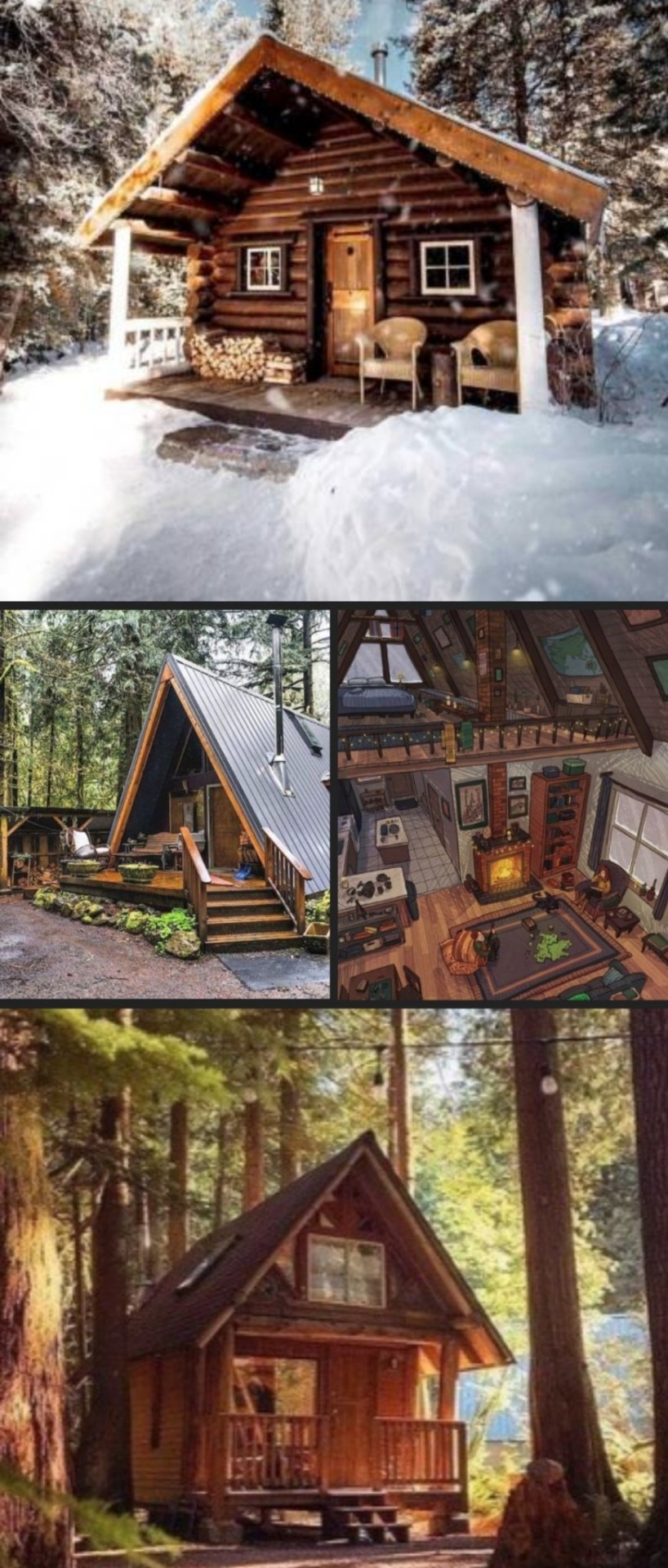
The idea is for the whole community to be gridless with individual power setups based on the terrain around the homes, meaning solar, hydro, biogas digester, etc. The longhouse gets two power systems, one either hydro or solar, with a woodgas generator backup. The land immediately surrounding each home should be gardens and livestock shifting into native forests. Silviculture would be a community effort with constant renewal of the forest and supporting wildlife.
While not 100% self sufficient (nothing really is) this supportive community with homegrown food surrounded by a healthy forest could easily go extended periods of time without needing to leave, while operating on a very low cost of living.
#self sufficiency#self reliance#prepper#off grid#fjarlsland#cabins#a frame#timberframe#wood gas#biogas
101 notes
·
View notes
Text
youtube
How We Solved The Home Wind Turbine Problem. Whenever I cover wind turbines many of you ask about what’s available for home applications. At the moment, I’ve got both good news and bad news. The bad news is that the current market for residential wind is…less than great. The good news? We have a lot of new innovations that look to improve it. The team behind the U.S.-based startup Harmony Turbines is hoping to popularize wind energy for the masses and allow them to have their iPhone moment. Plus, if you remember our video on Aeromine’s rooftop models from last year, we have an update on how its “motionless” design is progressing out in the real world. But of course, these are far and away from the only companies working on bringing wind power generation to our backyards. Residential wind has to have its moment someday, but when? Or should I say, “but wind?”
Watch Why This NASA Battery May Be The Future of Energy Storage
• Why This NASA Battery ...
Mentioned Videos:
The Challenges of a Wind Turbine on Your Home
• The Challenges of a Wi...
How Can A Wind Turbine Be Motionless?
• How Can A Wind Turbine...
Video script and citations:
https://undecidedmf.com/how-we-solved...
Get my achieve energy security with solar guide:
https://link.undecidedmf.com/solar-guide
Follow-up podcast:
Video version -
/ @stilltbd
Audio version - http://bit.ly/stilltbdfm
#Undecided with Matt Ferrell#solarpunk#wind energy#wind turbines#clean energy#renewable energy#green energy#house#home#usa#Harmony Turbines#residental wind#Youtube
3 notes
·
View notes
Text
i got another camera so i can see if anything is lurking around the chicken coop
the camera is essentially the same as the cat security cameras that i got before our winter holidays trip - very high resolution, 3x optical zoom, infrared as well (with illuminator) - but this one doesn't need mains power and instead has built-in rechargeable batteries plus a solar panel.
i took it down to the coop to test its network connection this evening
and stuck it on top of the fence post where it will likely live


it's upside down in the test - it's designed to be mounted under the eaves of a house roof - for a more permanent installation i'll make a bracket attached to this post that it can be mounted "under". it has a 360° swivel so the bracket needs to have minimal vertical structure necessary to keep it steady.
no trouble accessing it directly (this brand lets you use memory cards & direct network transfer and avoid cloud storage)


despite being over 65m away from my closest network point
#chicken cam#compost cam#cat cam#i have fucking great network connectivity here i get like one or two bars of 4G usually#but that's usually enough for 200Mbps at the house though the chicken coop only gets about 10M because distance#there was a time my company paid $600/mo for a 1.544Mbps T1 line here so 10M fucking rocks honestly
2 notes
·
View notes
Text
A disaster of a project that may finally get powered up 🔋
0 notes
Text
Solar Power and batteries have the Potential to Change Our World
Its mind-blowing how much energy the sun produces for free every day. Adding solar panels and batteries is one of the best decisions you will ever make to save money. #BESS #ESS #solarplusbattery #energyindependence
The sun’s power is immense – enough to fuel our planet for millennia. While we haven’t fully tapped into this potential, solar technology is rapidly advancing. Let’s explore what solar can do for us today and how it transforms our future.
Harnessing the sun’s power changed everything! It’s not just about energy; it’s about a cleaner, more sustainable world.
But what does a solar-powered future…
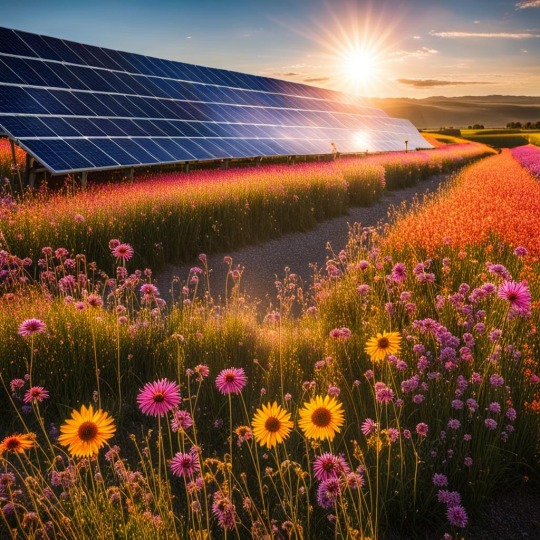
View On WordPress
#C&I#Energy Storage Systems#ESS#liquid cooled battery#micro grods#Solar plus battery#Wincle energy storage systems
0 notes
Text
The United States solar energy boom is finally taking off - in the worst way. In the Mojave desert and other federal lands across the West, utility-scale installations are putting gigawatt-hours of energy on the board and powering millions of homes. But the designs are sloppy, the labor conditions are horrific, and the environmental damage is incalculable. Ancient joshua trees are being clear cut, endangered desert tortoises are being left for dead, the vast biotic carbon stores of Mojave soils are being upturned, and the reflectivity of enormous expanses of desert are being altered, affecting the planetary climate.
But it doesn't have to be this way. There's a type of energy that requires no fuel and no land. It hardly even needs transmission lines, as it can be built at the site of use: rooftop solar. Every hour of the day, rooftops across the United States soak up enough sun to generate petawatts of power. Estimates for their potential to offset US energy demand range from 13 percent to over 100. Yet at present, only around 2 percent of US energy is generated by rooftop.
And then there's land area that's already been developed. Just by building solar on degraded lands, focusing on superfund sites, reservoirs, and farmland, researchers estimate we could generate more than enough to offset today's national energy demand. While there are points of dispute concerning some projections, the conclusion is clear: between the potential of degraded lands, rooftops, wind, and storage - plus existing hydro, nuclear, and other zero carbon energy sources, there's really no need to tear up the rare and fragile ecosystems of our deserts.
So why are the solar sites that should be our first priority being overlooked and the ones that should be our last resort being bulldozed?
Today, the primary obstacle to intelligent energy design is profit motive. Rooftop solar takes more work for less power. The overhead costs are high. The permits are onerous. The homeowner incentives are weak. Public lands, on the other hand, are the easy route. It's the path of least resistance and highest returns for energy corporations and utilities trying to turn a quarterly profit - even if they're nowhere near the people who need power. The reality is that a timely and just transition to renewable energy requires public investment. To achieve it, the grid must be taken into public hands.
In a confusing media landscape full of misinformation and conspiracies about renewable energy, the voices of experts criticizing renewable energy installations are often grouped in with climate deniers or "NIMBYs" and their concerns dismissed out-of-hand. We do this at our own peril. While we can point to the gains in gigawatts, we ignore the less quantifiable, yet grave damage to the ecosystems that we relied on to survive long before electricity. The legitimate and serious failures of our profit-motivated attempt at clean energy development must be interrogated if we are to build a resilient, efficient, and equitable grid. The window is narrowing to avert all-out climate apocalypse. Charting a course toward a sustainable future requires energy planning in which ecologists stand on equal footing with engineers. Heed their warnings.
9 notes
·
View notes
Text
Texans are cranking on the air conditioning this week amid an unusually early heat wave, setting new records for electricity demand in the state, which surpassed 75 gigawatts on Sunday and smashed the 2019 record. Texas grid operator ERCOT projects it could approach that peak again on Tuesday.
But unlike previous extreme weather events in Texas which led to deadly blackouts, the grid is holding up remarkably well this week. Several experts told CNN that it's owed in large part to strong performances from wind and solar, which generated 27 gigawatts of electricity during Sunday's peak demand -- close to 40% of the total needed.
"Texas is, by rhetoric, anti-renewables. But frankly, renewables are bailing us out," said Michael Webber, an energy expert and professor at the University of Texas at Austin. "They're rocking. That really spares us a lot of heartache and a lot of money."
Despite the Texas Republican rhetoric that wind and solar are unreliable, Texas has a massive and growing fleet of renewables. Zero-carbon electricity sources (wind, solar, and nuclear) powered about 38% of the state's power in 2021, rivaling natural gas at 42%.
This is a relatively recent phenomenon for the state.
"Wind and solar would not have been available in years in the past, so the growing capacity helps to alleviate reliance on natural gas and coal," said Jonathan DeVilbiss, operations research analyst at the US Energy Information Administration.
Not only have renewables helped keep the power on during a scorching and early heatwave, they have also helped keep costs low. Prices for natural gas and coal are high amid a worldwide energy crunch, but renewables -- powered by the wind and sun -- have no fuel cost.
"Because the price of wind and sunlight hasn't doubled in the past year like other resources, they are acting as a hedge against high fuel prices," said Joshua Rhodes, an energy researcher at UT Austin.
PEAK DEMAND DURING PEAK HEAT
Texas and other states have been sweltering in triple-digit temperatures and dangerous heat indices. Texas state climatologist John Nielsen-Gammon told CNN that San Antonio has been a particular hot spot; it recently hit 102.5 degrees Fahrenheit, setting a new pre-July record.
Texas is used to heat, but this year they're "getting August weather in May and June," Webber told CNN.
Experts said the Texas grid was built to withstand extreme heat moreso than the extreme cold brought by the deadly 2021 winter storm. But with the state now experiencing August-like temperatures in early June many questioned whether the Texas grid could withstand the longer, hotter summers fueled by climate change.
"As opposed to a winter storm, we were built for three months of 90-plus [degrees]," said Caitlin Smith, head of regulatory policy and communications at Texas-based battery storage company Jupiter Power. "Were we built for 4 months of 100-plus [degrees]? There's some uncertainty there."
If the early spikes in temperature persist this year, it could stress out the grid and power plants, Smith and Rhodes warned. As well as the grid is working right now, that could change if this summer continues to bring unrelenting heat.
"It's like the human body; heat stress is cumulative," Rhodes said. "The body has no time to recover. Power plants are like that as well, they need some time to recover."
Rhodes added that renewables have been a big help during this early surge by taking strain off the traditional thermal power plants that use coal and natural gas to keep the lights on.
Human-caused climate change is linked to rising global temperatures and extreme heat. And while it's too early to tell exactly how much climate change is to blame for the current heat wave, it's safe to assume it is a factor, said Andy Dessler who directs the Texas Center for Climate Studies at Texas A&M University.
"It's 100% certain that climate change is contributing to this," Dessler told CNN. "Everything's getting hotter. August is getting hotter; June is getting hotter. It is hot and this is the future."
OVERCROWDED TRANSMISSION LINES
Even though Texas is an oil and gas giant, renewables -- and particularly, wind -- have long been thriving there. Texas generates the most wind energy in the country: In 2020, it produced more wind electricity than Iowa, Kansas, and Oklahoma — the next three highest states — combined, according to the US Energy Information Administration.
Solar has been a smaller portion of the state's energy mix than wind, but it is growing as well. Solar generated about 4% of electricity in Texas last summer, and is expected to grow to 7.2% this summer, EIA projections show.
Building out more solar will be important to deal with heat waves in the depths of summer, when wind speeds tend to drop, experts told CNN. That's because if it's really hot out, there's a good chance the sun is beating down.
But Rhodes and Webber pointed to infrastructure issues limiting the potential of renewables; Texas needs more transmission lines to carry energy generated by renewables to customers. Rhodes pointed to ERCOT projects showing higher solar numbers than what was actually being used; a casualty of over-crowded power lines that can't let the power through to consumers.
"About half of the solar that could be produced is not being produced right now because there's no more room on the lines," Rhodes said. "The numbers for renewables would probably be higher if we had the transmission capacity to move them around."
Wind and solar have natural variability as well; solar can't generate energy during nighttime, and wind turbines don't turn when the wind isn't blowing. That is spurring a big focus on developing more massive batteries that can store and deploy renewable energy when the wind isn't blowing, and the sun isn't shining.
"It does keep growth of renewables strong; it allows you to firm up that renewable capacity," Smith said.
#us politics#news#cnn#texas#ercot#green energy#solar power#wind turbines#climate change#climate crisis#global warming#tx#2022#Michael Webber#Jonathan DeVilbiss#US Energy Information Administration#Joshua Rhodes#John Nielsen-Gammon#Caitlin Smith#jupiter power#Andy Dessler
60 notes
·
View notes
Text
Infected Solar AU
Thinking about the growing dread of Freddy on the repair Moon side quest. The first few parts could be maybe brushed off as spare parts left lying around. Then there’s too much that it cant just be spare parts. Realizing the pieces are everywhere. Part of the body of one of his friends was in his room and he didn’t even fucking notice. He still denied it in his mind for a bit, maybe this was all just some weird thing, he knew Moon disappeared but this couldn’t be his fate right? What shattered that idea was when Gregory found the hand in Bonnie Bowl. Moon’s right hand with the arcade ring Bonnie gifted him still on his finger.
When they found what was left of his endo in storage, along with his head, Freddy wasn’t even sure Moon’s body could be repaired. He wasn’t going to stop Gregory from trying though. Moon doesn’t look very great after being repaired but hey it’s better than his body parts being strewn around the Pizzaplex. Plus Solar can repair him better later, everyone’s lucky enough he’s even functional right now
4 notes
·
View notes
Photo
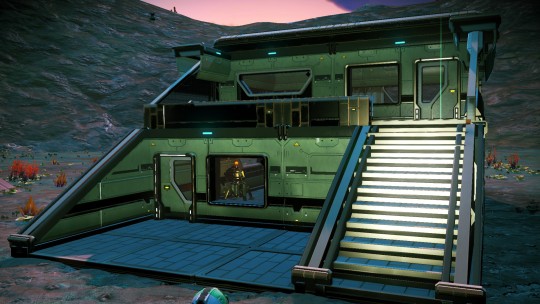
My latest gaming addiction - No Man’s Sky. Bought it on Steam in sales last week and after an initial “not sure if like or dislike” I’ve spent a disturbing number of hours running around and finding stuff and building mini-bases all over my starting solar system. This particular one is at the site of a crashed space freighter I’m salvaging stuff from (my only base so far in a second solar system is positioned at same). I have several sites I’ve named “Drydock” that were claimed just for the purpose of salvaging a wrecked ship and warping it to the space station to melt down for scrap (best haul so far netted me > 5 million units plus a storage upgrade for my own tiny ship). At some point when I have a lot more in the way of resources and technology, I might try actually repairing one of the crashed ships. Because why not.
I also like having bases handy to specific material types - like the one super-weird planet covered in coral-like desiccated creatures that are formed of both carbon and ferrite (two of the three main building materials, the other being silicate sand you can dig up anywhere), making it an awesome place to farm for more building materials any time I start running low. So much easier and faster than running around mining them from random plants and rocks on other planets, and I can just use my teleporter to step to there from any of my other bases if I need to gather more
So far if I had to describe my character I’d say they’re conflict-avoidant. Happy enough to just ignore the battles occurring around them, scavenge for salvageable crap, and build micro-bases. I am looking forward to unlocking more of the decor items so I can make bases that look comfortable, not just functional (I blame many years of playing The Sims for that interest...).
I’ve barely set foot outside my starting system yet, and don’t really have any interest so far in following the main storyline assignments or getting into any fights. I’ve only killed one pirate so far - mostly I just scram away from them as fast as my tiny ship can go - but I may beef up my weapons and shields a little, because being randomly attacked when I’m just minding my own business mining asteroids (for gold so I can build more solar panels) is getting old.
#Gaming#No Man's Sky#Euclid Galaxy#I have played a ridiculous number of hours already#As in just over 34 hours in the few days since purchase#I need to start setting a timer before I start playing#So that I have something reminding me to STOP#Because it's always#...just one more thing and then I'll log off#And then I glance at the clock and it's an hour or two later
50 notes
·
View notes